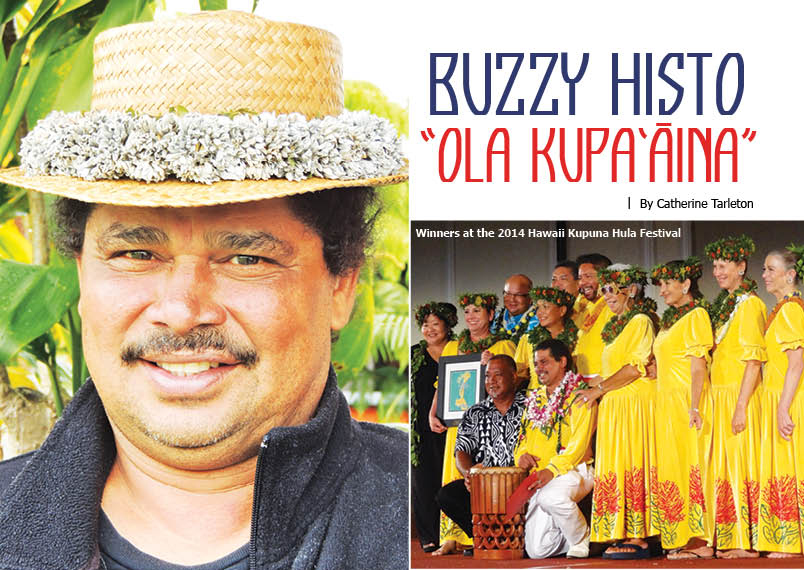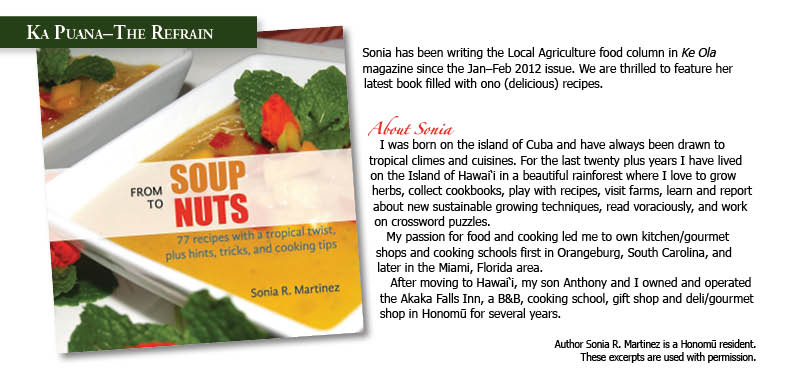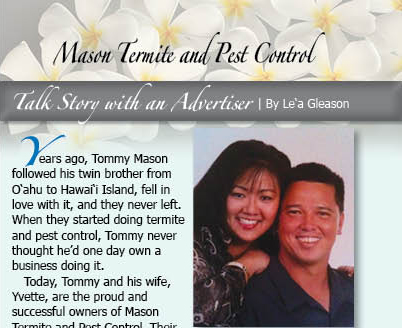
Buzzy Histo “Ola Kupa‘āina”

By Catherine Tarleton
How can you not give them 10+? Everybody deserves a 10. They’re all winners,” says hula instructor, lei-maker, and floral artist Buzzy Histo from his Kalikokalehua Hula Studio in Waimea. A judge for the Hawaii Kupuna Hula Festival (HKHF) for many years, Buzzy will bring his hālau back to defend their titles in the 33rd annual event September 9–10 at the Sheraton Kona Resort & Spa at Keauhou Bay.
“Ours was the first group—in over 30 years of the festival—to win all four divisions,” says Buzzy of the 2014 competition. “Men, women, co-ed, and overall. Plus solo wahine, third place.”
Limited to twenty hālau, the Hawaii Kupuna Hula Festival is a way to spotlight the mature dancers over age 55 and offer them a competitive experience. Sponsored by the Hawai‘i County Elderly Activities Division‑Special Programs, HKHF is the longest running kupuna hula festival in the world, welcoming dancers from the Hawaiian Islands, California, Japan, and Okinawa.
This year’s theme, “Ola Kupa‘āina” (A Person/Persons of the Land), challenges competitors to select a song about a place in Hawai‘i with special meaning for them. Kalikokalehua Hula Studio’s wahine group will perform Paniau by Helen Desha Beamer, written as a tribute to her friends’ beach home.
“Paniau is in Puako, and my friend’s family used to own a home there,” says Buzzy. “That was the first huaka‘i (trip, journey) that I took on this island.” For their lei, he is recruiting friends from near and far to gather kou flowers, the lacy orange blossom that grows in coastal areas.
“Kupuna Hula Festival takes the whole year to prepare,” says Buzzy. “You want to be good and know the song inside and out.” The men’s group will dance Waikaloa by John P. Watkins, about a special place near Hāna, Maui. For hō‘ike, he chose the song Lei Nani.
“We used to do it traditional like Aunty Genoa,” he says, “but I heard O’Brian Eselu sing it, and had to do it his way to honor him. It has more of a flare, more uplifting.” Under his gentle kāhea (to call, recite), the group moves forward and back in unison, hands draped with ribbon to represent their lei.
“The group found me,” says Buzzy of his 16 dancers. He started teaching at the request of Waimea Seniors Club and the group evolved into a hālau. “Only Aunty Betty is left,” he says, referring to “the sunglass lady,” Betty Webster, 86, of Waimea, whose collection of 1,200+ shades is in the running for a Guinness World Record. Betty has been a hula dancer since age nine.
“He is very akamai, very smart, very creative,” says Betty, “I wouldn’t say really strict. There’s more horsing around…I enjoy working with him.” Betty, like her hula brothers and sisters, works hard to perfect her performance, knowing that the HKHF judges will be evaluating them on overall appearance, presentation, hand gestures, and costumes.
“It is very challenging,” she says. “The motions are not that simple…and you are judged very highly on your feet.”
“We do formations; switching lines,” says Buzzy. “You want to enter competition, it’s so much more exciting, rather than everybody standing in the same place.” He enjoys working with the kūpuna, and they with him.
“He’s a character,” says student Sherry Pettus of Honoka‘a. “He always makes us laugh. He’s very patient with us. He’s a beautiful dancer and I love watching him dance…I love our Thursday mornings with him.”
“Actually, they should be teaching me!” he says. “The kūpuna are willing to try stuff too—that’s the fun part about it—even if they never danced before, they want to try. You just have to have that desire.”
Growing up in Kāne‘ohe, O‘ahu, he danced with Aunty Lei Mendez of Hau‘oli Hula Studio and Luka and Kalei Ki of ‘Ilima Hula studio, as well as the late Uncle George Na‘ope.
“I have good foundations,” he says, remembering how the stricter kumu would charge a $5 fine for forgetting a kukui nut lei, a $5 fine for a ti leaf lei that was brown.
“Uncle George was the meanest!” says Buzzy. “He was the only one who would whack us with the pū‘ili [bamboo rattle] or with his slipper. And you can’t go home to your mother and say ‘I got lickings in hula,’ because you’ll get lickings again!”
Uncle George helped found the Merrie Monarch Festival in 1964. And with George Yoshida of the Department of Parks and Recreation, he also created HKHF in 1982 as an activity for senior citizens clubs. In between, in 1977, Uncle George took his hālau, including Buzzy, to the Merrie Monarch Festival competition.
“It was held at the gym where they have the craft fair now,” says Buzzy. “They didn’t have a stage. We danced on the ground.” Over the next three years, he danced with Kumu Darrell Lupenui and the Men of Waimapuna, and in 1980 they danced on the big stage at Edith Kanaka‘ole Stadium.
“The roar of the crowd was so incredible,” says Buzzy. “And it felt like dancing in the clouds because you are above the audience. Our hula had lots of ku‘i steps (a strong, pounding foot motion) and the excellent choreography. It was super cool.” That year, they took home the first perpetual trophy ever awarded to a men’s hālau. In the five years that followed, Buzzy danced for Johnny Lum Ho, returning to the Merrie Monarch stage annually.
He moved to Hawai‘i Island in 1984. “I came to the Big Island because this is the best island to pick all the native Hawaiian flowers,” he says. Like most artisans, Buzzy has a professional career as well. At first, he wanted to be a flight attendant, but after a few trips by plane, realized it was not for him.
“I knew my feet had to be on the ground,” says Buzzy. “I’m an earthy person.”
He worked at Mauna Lani Bay Hotel & Bungalows for 25 years as a server, although his passion and talent for hula and lei-making were always part of the job. With Pinkie Crowe, Director of Weddings and Romance and also an accomplished hula dancer, he would plan the annual May Day shows and other festivities.
“Pinkie would come into the restaurant and say, ‘Sorry Buzzy, I have to take you away,’ because she needed a special flower arrangement or a lei…That was our job, to serve our guests,” he says with emotion, revealing a deeper aloha for his work and for service, in a place he obviously loved.
His lei very much in demand, Buzzy’s hands are seldom still. His refrigerators are full of blossoms and greenery. And while you may find him sewing lei in his Waimea studio, he might be off giving hula lessons to a writer for Condé Nast Traveler, designing the floral set for Keali‘i Reichel’s concert at Kahilu Theatre, arranging flowers at Alan Wong’s lū‘au for Gourmet magazine, or teaching a lei-making workshop in Paris.
“I asked my mother, ‘Why did you name me Buzzy? It always keeps me so busy!’” Indeed, with lei to make for 11 hālau at Merrie Monarch this year, he started about two months in advance, working first with the greenery, like palapalai. “KITV has been trying to get me [to make lei] for years, but I have to say no!”
He learned to make lei from renowned lei-maker Hanai Ali‘i Hayashida of Waimea, whose father was a Parker Ranch paniolo for more than 50 years. Hanai Ali‘i taught Buzzy how to make Ni‘ihau shell lei as well, including the one he gifted himself for his 50th birthday.
Recently, he celebrated his 55th birthday, entering the realm of the kupuna himself. When asked what his goals or dreams are, what’s on his ‘bucket list,’ if money were no object—he was stumped, speechless, his humility showing through the humor and stories. If one had to guess, it might be another win at this year’s Hawaii Kupuna Hula Festival.
Break a leg Buzzy and Kalikokalehua Hula Studio! ❖
Contact Buzzy Histo: 808.885.7487
Contact the writer


